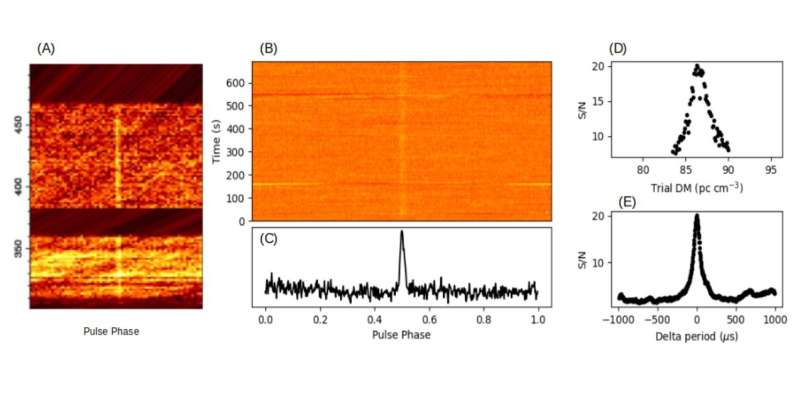Detection of the pulsar J1245−52, discovered in the GHRSS survey. (A) Frequency versus pulse phase plot, obtained from post-processing and added to RIPTIDE output for better visualization of the broadband nature of the signal. (B) Time versus pulse phase plot. (C) Integrated pulse profile. (D) Plot of achieved signal-to-noise ratio (S/N) versus trial dispersion measure (DM), and (E) Plot of the detection S/N versus trial period. Credit: Singh et al, 2022
Astronomers report the detection of four new pulsars using the Giant Metrewave Radio Telescope (GMRT) as part of the GMRT High Resolution Southern Sky (GHRSS) survey. The finding was detailed in a research paper published October 29 on the arXiv pre-print repository.
Pulsars are highly magnetized, rotating neutron stars emitting a beam of electromagnetic radiation. They are usually detected in the form of short bursts of radio emission; however, some of them are also observed via optical, X-ray and gamma-ray telescopes.
Now, a team of astronomers led by Shubham Singh of the Tata Institute of Fundamental Research in Pune, India, has discovered four new pulsars using the fast folding algorithm (FFA) search method. FFA, based on folding of the time series, has a superior sensitivity to search for signals with long periods and short duty cycles. Sinhg's team processed the GHRSS survey data with the newly implemented FFA search pipeline.
"In the GMRT High Resolution Southern Sky (GHRSS) survey, we are using an FFA-based pipeline to search for isolated pulsars in a period range of 100 ms to 100 s.... Here, we present the results from processed data covering the next 1,300 deg2 of the sky, resulting in four new discoveries," the researchers wrote in the paper.
The newfound pulsars are designated J1245-52, J1447-50, J1810-42 and J1936-30. They have spin periods between 532.2 and 1,675.8 milliseconds, and dispersion measures within a range of 42.2–107.8 pc/cm3. Their flux values were estimated to be from 0.4 to 1.5 mJy.
It was noted that J1936-30 is a narrow duty cycle nulling pulsar with an extreme nulling fraction of about 90%. Pulse nulling, which is relatively common in pulsars, is a phenomenon in which the pulse energy suddenly drops to zero or near zero and then just suddenly returns to its normal state.
In the case of J1936-30, the astronomers found that it exhibits regular nulling in the discovery epoch of 10 minutes duration. Follow-up observations of this pulsar at multiple epochs, revealed that it shows burst phases (when the emission is seen) and null phases (when the pulsar is nulling and no emission is seen) lasting between a few minutes to a few tens of minutes.
Moreover, it turned out that J1245-52 and J1447-50 are also among the smallest duty cycle pulsars of the total population. The researchers noted that this finding demonstrates the capability of the FFA search to recover small duty cycle pulsars that could be missed by the Fourier transform (FFT) based periodicity search method.
"The conventional FFT-based search method has a bias against long period and small duty cycle pulsars. Since most of the known pulsar population has been discovered by the conventional FFT search, there is a possibility of missing the population of long period and small duty cycle pulsars. This missing population can be recovered by implementing the FFA search in the major pulsar surveys," the authors of the paper concluded.
More information: Shubham Singh et al, The GMRT High Resolution Southern Sky Survey for pulsars and transients—IV: Discovery of 4 new pulsars with an FFA search, arXiv (2022). DOI: 10.48550/arxiv.2210.16650
Journal information: arXiv
© 2022 Science X Network
























